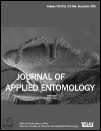Ver ítem
- xmlui.general.dspace_homeCentros Regionales y EEAsCentro Regional Patagonia NorteEEA BarilocheArtículos científicosxmlui.ArtifactBrowser.ItemViewer.trail
- Inicio
- Centros Regionales y EEAs
- Centro Regional Patagonia Norte
- EEA Bariloche
- Artículos científicos
- Ver ítem
Host selection by Ibalia leucospoides based on temporal variations of volatiles from the hosts’ fungal symbiont
Resumen
Insect parasitoids locate hosts via reliable and predictable cues such as volatile emissions from hosts and/or host plants. For insects that depend on mutualistic organisms, such as many wood-boring insects, symbiont-derived semiochemicals may represent a source of such cues to be exploited by natural enemies. Ultimately, exploitation of these signals may increase fitness by optimizing foraging efficiency. Female parasitoids of Ibalia leucospoides use
[ver mas...]
Insect parasitoids locate hosts via reliable and predictable cues such as volatile emissions from hosts and/or host plants. For insects that depend on mutualistic organisms, such as many wood-boring insects, symbiont-derived semiochemicals may represent a source of such cues to be exploited by natural enemies. Ultimately, exploitation of these signals may increase fitness by optimizing foraging efficiency. Female parasitoids of Ibalia leucospoides use volatiles from the fungal symbiont Amylostereum areolatum of their host Sirex noctlio to find concealed host eggs and young larvae within the xylem. We hypothesize that the temporal pattern of fungal emissions may indicate not only the presence of host larvae but also be used as a cue that indicates host suitability and age. Such information would allow female parasitoids to discern more efficiently between hosts within ovipositor reach from those already buried too deep into the xylem and out of reach. In this context, we assessed the behaviour of I. leucospoides females to volatiles of A. areolatum in a ‘Y’-tube olfactometer at regular intervals over 30 days. We concurrently examined the fungal volatiles by headspace sampling through solid-phase microextraction (SPME) followed by gas chromatography mass spectrometry (GC-MS). We observed that females were attracted to volatiles produced by two-week-old fungal cultures, a period that matches when older larvae are still within ovipositor reach. Four chemical compounds were detected: ethanol, acetone, acetaldehyde and the sesquiterpene 2,2,8-trimethyltricyclo[6.2.2.01,6]dodec-5-ene, with each compounds’ relative abundance changing over time. Results are discussed in the context of parasitoids fitness. Future studies involving electrophysiology, different collection techniques and further behavioural assays will help in identifying the compounds that convey temporal information to female parasitoids and have the potential for being used in integrated pest management programmes.
[Cerrar]

Autor
Jofre, Nelida Raquel;
Pildain, María Belén;
Cirigliano, A.M.;
Cabrera, G.M.;
Corley, Juan Carlos;
Martinez Von Ellrich, Andres;
Fuente
Journal of Applied Entomology 140 (10) : 736–743 (December 2016)
Fecha
2016-12
ISSN
0931-2048 (Print)
1439-0418 (Online)
1439-0418 (Online)
Formato
pdf
Tipo de documento
artículo
Palabras Claves
Derechos de acceso
Restringido
 Excepto donde se diga explicitamente, este item se publica bajo la siguiente descripción: Creative Commons Attribution-NonCommercial-ShareAlike 2.5 Unported (CC BY-NC-SA 2.5)
Excepto donde se diga explicitamente, este item se publica bajo la siguiente descripción: Creative Commons Attribution-NonCommercial-ShareAlike 2.5 Unported (CC BY-NC-SA 2.5)

